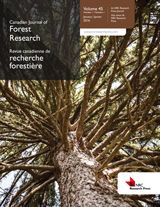Brubaker et al., 2018
Spatial patterns of tree and shrub biomass in a deciduous forest using leaf-off and leaf-on lidar
Brubaker Kristen M., Johnson Quincey K., and Kaye Margot W. (2018)
Canadian Journal of Forest Research, 48: 1–14
-
Shale Hills, INVESTIGATOR, COLLABORATOR
-
Shale Hills, INVESTIGATOR
Abstract
Understanding patterns of aboveground carbon storage across forest types is increasingly important as managers adapt to threats of global change. We combined field measures of aboveground biomass with lidar to model fine-scale biomass in deciduous forests located in two watersheds; one watershed was underlain by sandstone and the other by shale. We measured tree and shrub biomass across three topographic positions for both watersheds and analyzed biomass using mixed models. The watershed underlain by shale had 60% more aboveground biomass than the sandstone watershed. Although spatial patterns of biomass were different across watersheds, both had higher (between about 40% and 55%) biomass values at the toe-slope position than at the ridge-top position. To model fine-scale spatial patterns of biomass, we tested the effectiveness of leaf-on and leaf-off lidar combined with topographic metrics to develop a spatially explicit random forest model of tree and shrub biomass across both watersheds. Leaf-on variables were more important for modeling shrub biomass, while leaf-off variables were more effective at modeling tree biomass. Our model of tree and shrub biomass reflects the distribution of biomass across both watersheds at a fine scale and highlights the potential of abiotic factors such as topography and bedrock to affect carbon storage.
Citation
Brubaker Kristen M., Johnson Quincey K., and Kaye Margot W. (2018): Spatial patterns of tree and shrub biomass in a deciduous forest using leaf-off and leaf-on lidar. Canadian Journal of Forest Research, 48: 1–14 . DOI: 10.1139/cjfr-2018-0033
 This Paper/Book acknowledges NSF CZO grant support.
This Paper/Book acknowledges NSF CZO grant support.
Explore Further



